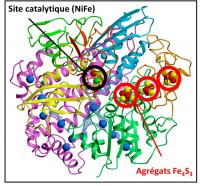A hydrogen fuel cell involves the creation of an electric current
between two electrodes. At one electrode, hydrogen is oxidized by losing two
electrons. These electrons migrate to the other electrode to participate in the
reduction of oxygen, and create an electric current.
Oxidation reaction: H2 → 2H++ 2e-
Reduction reaction: 4H++ 4e- +
O2 → 2 H2O
Conventional devices, which use a proton exchange membrane and a platinum
catalyst, are still expensive (for more information: Production d’hydrogène: si le cobalt remplaçait le platine… ).
A team from the IBS has shown that
certain bacterial enzymes are very effective at oxidizing hydrogen from
the air and sending the electrons to the catalytic site where the oxygen will be
reduced. This biofuel cell naturally performs within Escherichia
coli, thanks to a hydrogenase that has a series of aggregates composed of
iron and sulfur in a particular geometry (Fe4S3) forming a
link between its surface and the catalytic site.
 Crystallography studies and calculations made in collaboration with the CEA-Inac
and Oxford University show how this tiny biological power station functions,
which is typically capable of powering a watch for several hours. Unlike classic
hydrogenases that are damaged by atmospheric oxygen, this enzyme is able to send
(thanks to the Fe4S3 aggregate) not one, but two electrons
from its surface to the catalytic site and to rapidly reduce the oxygen,
producing water. Due to the speed of this reaction, the oxygen does not have
time to damage the enzyme’s catalytic site. This “super oxidation”
ability could ultimately inspire the industry in producing biomimetic fuel
cells.
Crystallography studies and calculations made in collaboration with the CEA-Inac
and Oxford University show how this tiny biological power station functions,
which is typically capable of powering a watch for several hours. Unlike classic
hydrogenases that are damaged by atmospheric oxygen, this enzyme is able to send
(thanks to the Fe4S3 aggregate) not one, but two electrons
from its surface to the catalytic site and to rapidly reduce the oxygen,
producing water. Due to the speed of this reaction, the oxygen does not have
time to damage the enzyme’s catalytic site. This “super oxidation”
ability could ultimately inspire the industry in producing biomimetic fuel
cells.